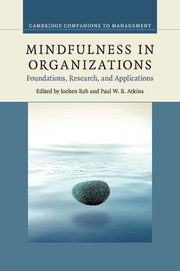Book contents
- Frontmatter
- Contents
- List of figures
- List of tables
- List of contributors
- Foreword
- Preface
- Part I Foundations
- 1 Introduction
- 2 What is mindfulness, and why should organizations care about it?
- 3 Mindfulness: historical and contemplative context and recent developments
- 4 Methods of mindfulness: how mindfulness is studied in the workplace
- 5 Applying mindfulness in the context of work: mindfulness-based interventions
- Part II Research
- Part III Applications
- Index
- References
4 - Methods of mindfulness: how mindfulness is studied in the workplace
from Part I - Foundations
Published online by Cambridge University Press: 05 July 2015
- Frontmatter
- Contents
- List of figures
- List of tables
- List of contributors
- Foreword
- Preface
- Part I Foundations
- 1 Introduction
- 2 What is mindfulness, and why should organizations care about it?
- 3 Mindfulness: historical and contemplative context and recent developments
- 4 Methods of mindfulness: how mindfulness is studied in the workplace
- 5 Applying mindfulness in the context of work: mindfulness-based interventions
- Part II Research
- Part III Applications
- Index
- References
Summary
Introduction
Interest in mindfulness in the workplace has been on the rise. A recent surge of research has built a compelling case for mindfulness and its potential benefits continue to attract the attention of organizational scholars. To name but a few, in the past years we have seen research linking mindfulness to work-family balance (Allen and Kiburz 2012), work engagement (Leroy, Anseel, Dimitrova, and Sels 2013), negotiation outcomes (Reb and Narayanan 2014), job burnout (Roche and Haar 2013), resilience to bias (Hafenbrack, Kinias, and Barsade 2013), working memory (Mrazek et al. 2013) and performance (Dane and Brummel 2014; Reb, Narayanan, and Chaturvedi 2014). While mindfulness was initially studied as a method of treating ailing clinical populations (Kabat-Zinn 1990), today its application has expanded to executive boardrooms, elementary school classrooms, professional sports, and military Special Forces. The rapid expansion of mindfulness studies in non-clinical populations, particularly work environments, is exciting for practitioners but also raises a series of methodological concerns. It is to this end that we focus this chapter: a review and analysis of the study of mindfulness in the workplace. We hope this chapter will offer a roadmap to scholars new to mindfulness by summarizing prevailing methods and their areas for improvement. We also aim to offer innovative insights for more established researchers by reflecting on directions for further research.
This chapter discusses the study of workplace mindfulness in three sections. First, we review how researchers have studied the various conceptualizations of mindfulness and the major issues concerning the construct of mindfulness altogether. Clearly operationalizing mindfulness is an important precursor to any other step in the research process for it stands to help define the scope and boundaries of the topic under investigation. In the second section, we review the most commonly used methods in mindfulness research such as experiments, surveys, and mindfulness-based interventions (MBIs).
- Type
- Chapter
- Information
- Mindfulness in OrganizationsFoundations, Research, and Applications, pp. 67 - 99Publisher: Cambridge University PressPrint publication year: 2015
References
- 13
- Cited by

